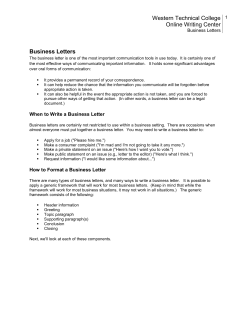
Writing Descriptive and Narrative Paragraphs g p PowerPoint
Writing Descriptive and g p Narrative Paragraphs PowerPoint® for the Classroom Punctuation Practice PowerPoint, © March 2008 by Prestwick House, Inc. All rights reserved. ISBN 978-1-60843-751-1 Item #: 303128 By Elizabeth Osborne In this presentation, we’ll discuss two kinds of writing: • Descriptive • Narrative Descriptive writing describes something. Narrative writing tells a story. D Descriptive i ti Paragraphs P h Using Sensory Details, Using Specific Language Using Figurative Language Language, Using Sensory Details Using Sensory Details Look at the following descriptive paragraph: As you approach the front door, you travel along a winding walkway surrounded on either side by deep purple morning glories and red red-orange orange tiger lilies. Just beyond are the smooth leaves and waxy blossoms of a magnolia in bloom; the lilac bush is out of sight around the side of the house, but its presence is carried on the spring p g breeze. The three wooden steps, p all slightly g y different sizes, but worn to the same slick finish, creak loudly as you mount the porch. Which of your five senses does the author appeal to in this paragraph? Using Sensory Details Descriptive writing uses details from any or all of the five senses to convey the essence of something to the reader. The reader sees, hears, feels,, smells, and tastes what the writer describes. N Narrative ti Paragraphs P h Organizing Figurative Language, Tone, Expanding Paragraphs by Asking Questions Organizing Figurative Language Organizing Figurative Language Narrative writing tells a story. You have probably been telling stories as long l as you have h been b communicating i i with i h other h people. l Without Wi h even thinking about it, you set the story up for your listener, describingg the time, pplace, and yyour own involvement. Maybe y the story is about something that happened to you, or maybe it’s about something that happened to a person you don’t even know. Organizing Figurative Language When you are writing a narrative paragraph, you have to make the same decisions as you would if you were telling a story aloud. First, how will your story be organized? Will it start in the present and then move to the past, past or will it start in the past and move forward? You must decide on the organization of time in the story. Organizing Figurative Language The spatial organization (having to do with space) is also important. If yyou’re describingg an event,, how do yyou want yyour reader to see it? Will the action be seen from your point of view or someone else’s? Do you want to start with a broad scene and zoom in, or do you want to take your reader on a walk across the landscape? What other things might you consider when deciding the organization of your narrative paragraph?
© Copyright 2025





















